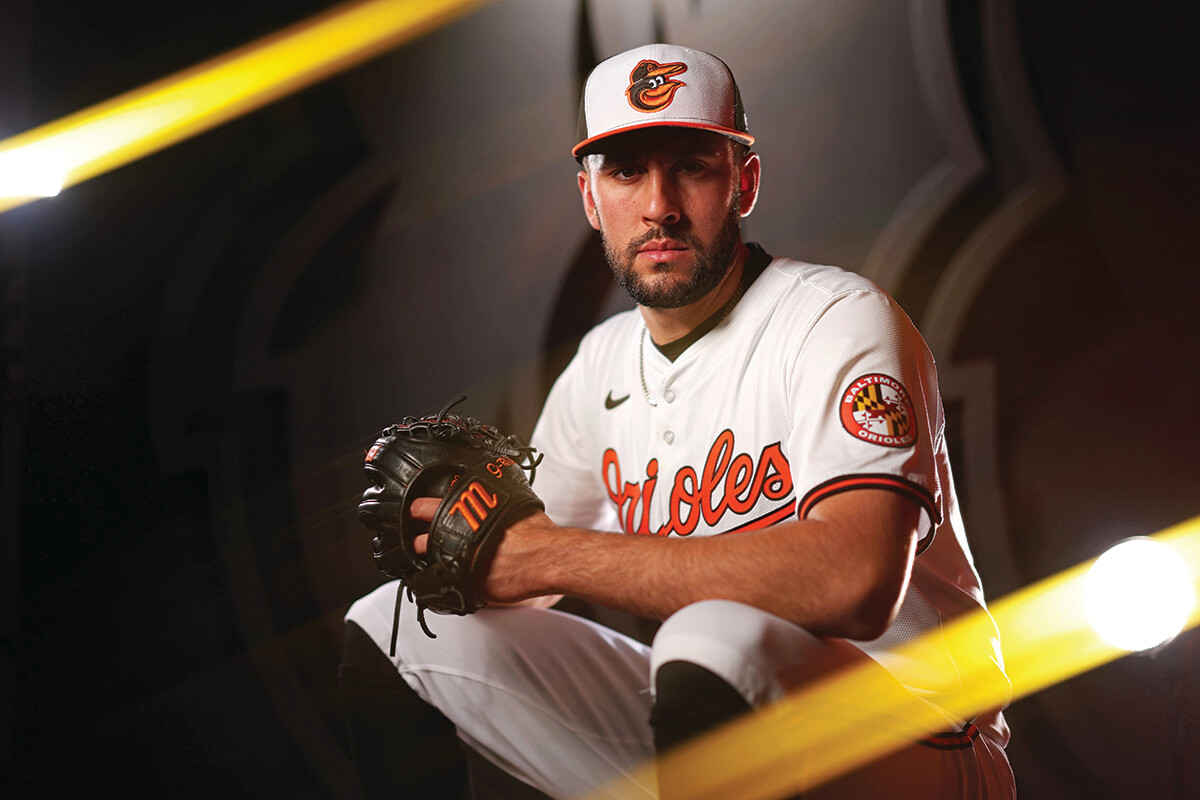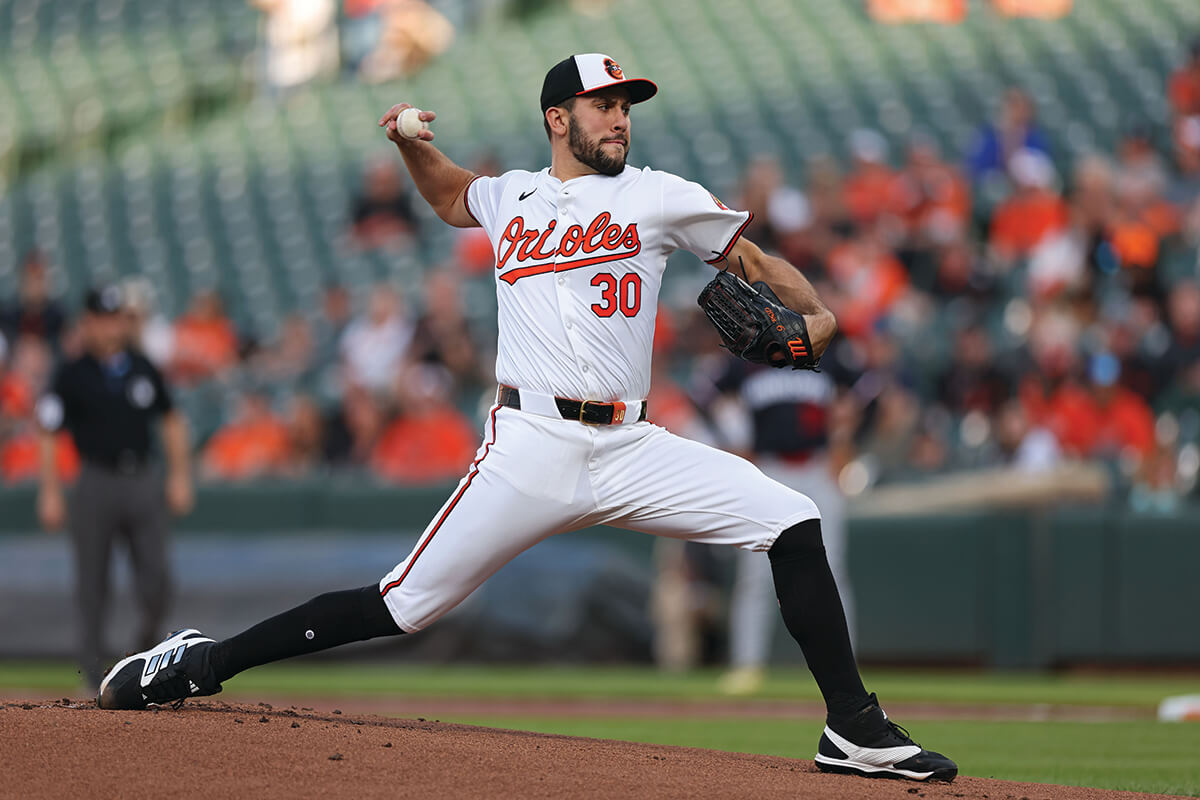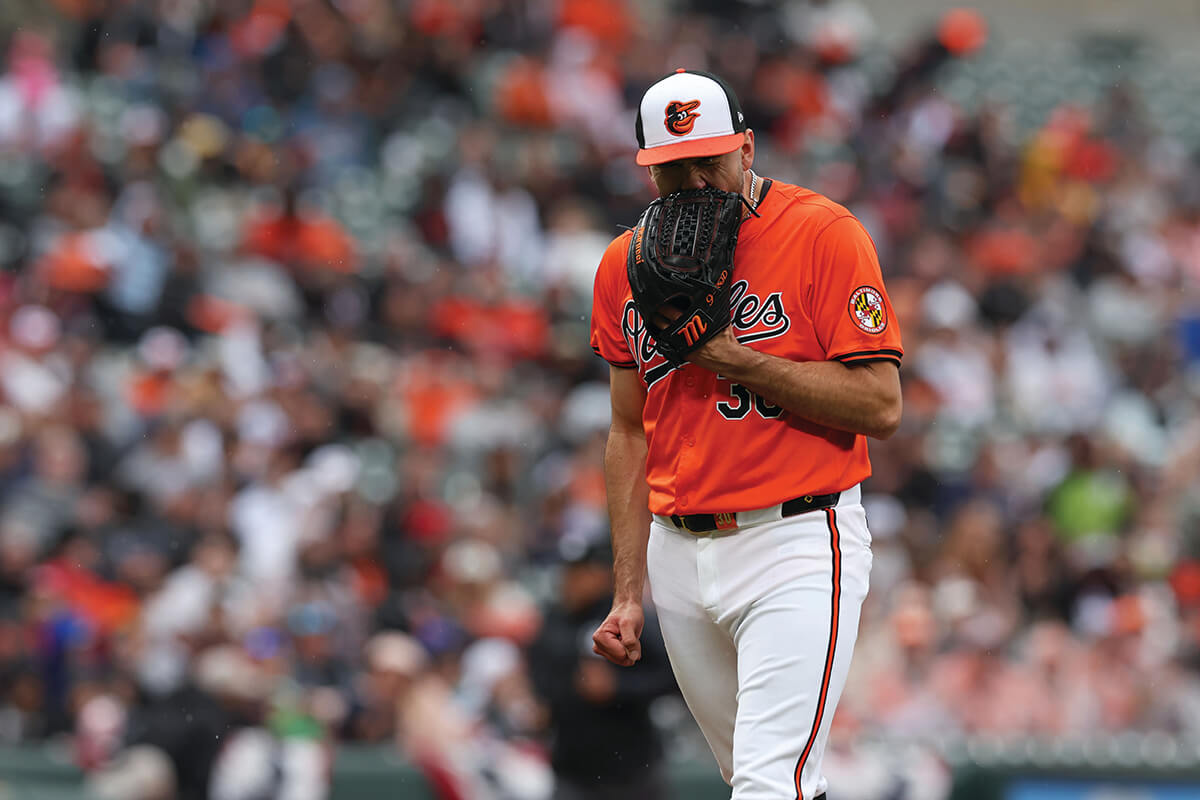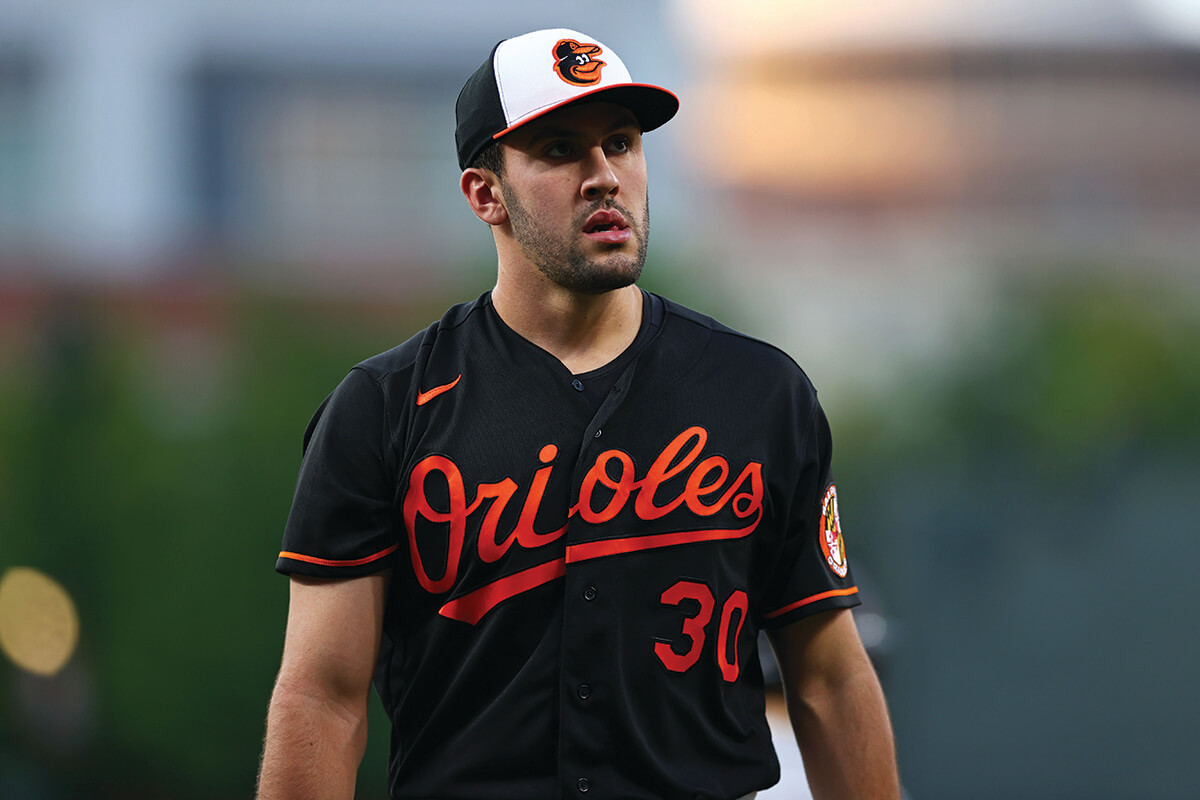Sports
How Grayson Rodriguez Quickly Became One of the Top Pitchers in Baseball
The Texas native—a bowhunter who grew up practicing on a ball field his family built on their property—is now a bona fide big leaguer.

Maybe the most telling bit of lore about Orioles pitcher Grayson Rodriguez begins, ironically, with a home run.
“Growing up, I was actually a better hitter than a pitcher,” he says, though this story features a blend of both skills.
In the first scrimmage of his junior year at Central Heights High School in the small East Texas city of Nacogdoches, the already 6-foot-5 Rodriguez swung hard at an inside fastball. A left-handed batter, he muscled a homer to right field but hurt his pitching hand (the right one) in the process—wrist tendinitis, an athletic trainer later told him.
For the rest of the season, it pained him to hit and throw, but even with a compression wrap around his hand, he still threw harder than 90 miles per hour. Still, it wasn’t quite the more attention-grabbing 95 mph that had put him on pro prospect lists a year earlier. Scouts, who’d been coming around, stopped showing up for his starts. Rodriguez guessed they thought he was regressing and maybe wrongly presumed he’d become complacent, already having an offer to play college ball at nearby Texas A&M.
What they—and he—didn’t know was that Rodriguez was throwing with a broken hand. A doctor’s visit following the season revealed he had a cracked hamate bone. It’s just below the pinky and ring finger, a delicate spot, especially for a pitcher who relies on gripping a baseball. After surgery to repair the break, Rodriguez’s velocity returned—he reached 98 miles per hour as a senior—and the scouts did, too.
Six years later, the stakes and expectations could not be higher. At 24, he’s more seasoned and more muscular, though at 230 pounds, given his height, he’s still not bulky.
The fastball he slings now at Camden Yards often touches 100 miles per hour, running in on righties and away from lefties. The off-speed pitches he has developed since he was drafted with the 11th overall pick in 2018—like an 85-ish mile-an-hour changeup that drops an average of three feet—often confound the best pro hitters.
“I feel like I’m a very competitive person, and baseball is something I can do where I can be competitive,” Rodriguez told Baltimore at the start of the season. “I like the one-on-one, me versus the hitter, being able to have a fight with the guy that steps in the box, every five days. It’s a lot of fun.”
Today, with stops at Orioles minor-league affiliates in Delmarva, Bowie, Aberdeen, and Norfolk, Virginia, behind him, Rodriguez is a bona fide big leaguer and the most electric and beloved homegrown hurler on the O’s roster. He sits among the Major League leaders in wins and strikeouts through his first five starts, and gives last year’s AL East division champs a chance to win every time he takes the mound. (Dedicated fans on social media celebrate “Grayson Rodriguez Day” when it’s his turn to pitch.)
“He’s got the ability to reach triple-digits as a starter, and he’s got the ability to do it late in the game, late in the season, and that’s not something you see very often,” says Norfolk Tides pitching coach Justin Ramsey, whose career in the Orioles’ farm system rose alongside Rodriguez. “And he’s a freak when it comes to how he’s able to generate the spins on the baseball, whether it’s the fastball, the breaking balls, the changeups, whatever. It’s special. The sky’s the limit for him.”

When Rodriguez was growing up in the Lone Star State, his dad, Gilbert, who had played outfield at a small West Texas college, built a field on the family’s 13-acre property for his son to practice. He cleared brush, used a tractor to level a slope, and added a dirt mound and baselines—and eventually a 200-foot home run fence. It was a practical matter. A field in town they liked to use was often occupied. Young Grayson didn’t need any extra encouragement.
“I just always wanted to play baseball,” Rodriguez says.
The sport is in the family blood. His mother, Temple, was a softball coach. Not-so-little Grayson had hands big enough at 10 to utilize the seams on a baseball to create uncanny spin, an arm strong enough at age 12 to make a catcher’s mitt pop, and the size, strength, and swing as a teenager to hit a ton of home runs.
But it wasn’t until he was a high school senior that he learned the fundamentals of a good windup and delivery, and how to use his lower body to generate power, thanks to instruction from mentors like David Evans, a former O’s pitcher who ran a training facility near Houston, a two hour and 15 minute drive south from Nacogdoches.
On draft day, however, Rodriguez had no clue the Orioles were planning to pick him so high until he and his family heard his name announced on television during a selection show watch party at home.
In many ways, Rodriguez remained raw when he first joined the organization. He was all power, little finesse. Not until 2019, after the O’s current front-office and coaching regime led by general manager Mike Elias and manager Brandon Hyde took over, did Rodriguez develop a second “out” pitch to complement his heater—a changeup with unusual downward movement. With high-speed video cameras showing how the ball, depending on the grip, left his hand, Rodriguez learned quickly and was repeating the pitch consistently in two days.
Nonetheless, as is the case with most ballplayers, there were unexpected roadblocks on his path to the majors. First, the pandemic hit. He suffered a back muscle injury in 2022. Then he had a few false starts en route to The Bigs, leading to a bout of self-doubt.
Despite years of recognition as one of the top pitching prospects in the game, Rodriguez did not get his first real taste of major league ball until last April. He had struggled in spring training in 2023, did not make the Opening Day roster last season, and instead started the year in Norfolk. Only out of necessity, after an early-season injury to Kyle Bradish, did Rodriguez get called up last April. Then, after a couple of uneven months, he was sent back down.
Back with the Tides, Rodriguez proved resilient, regrouping with Ramsey, finding better form, more reliable command, and maybe most importantly, renewed confidence.
“It was partially a rhythm and timing thing of delivery we were working on,” Ramsey recalls, “but also just the intent to get [the pitch] there, trust it, and not try to be too fine.”
“WHEN HE’S ATTACKING THE STRIKE ZONE RIGHT AWAY, GOOD THINGS CAN HAPPEN FOR HIM.”
Rodriguez returned to Baltimore in July, and he delivered, posting a 2.58 earned run average the rest of the season, a massive improvement over his 7.35 mark in the first half. He struck out more batters, yielded fewer home runs, and held opponents to a .227 batting average after the mid-season call-up. A dominating eight-inning, seven-strikeout performance against rival Tampa Bay in the middle of the division title race demonstrated why so many have long considered Rodriguez ace material.
“He’s got such a good fastball and change-up,” Hyde says of his young right-hander. “If he gets 0-1 on hitters, it puts the hitter in a defensive mode because his stuff is so good. When he’s attacking the strike zone right away, good things can happen for him.”
When everything is clicking, you can see Rodriguez scream with excitement into his glove after a strikeout or successful inning. His emotion on the field belies what could otherwise be described an unassuming nature—that is, as unassuming as 6-foot-5 can be.
He is friendly and approachable with teammates, coaches, friends, and the media. He speaks with a charming Texas accent and is gracious with his time. On his non-pitching days, he laughs easily, trades friendly trash talk, and plays video games like Call of Duty.
And while baseball has him in Baltimore and on the road for most of the year, he’ll tell you he’s a homebody and country boy at heart. The first thing he bought with his $4.3-million signing bonus was a Ford F250 pick-up truck. In December, Rodriguez married his high school sweetheart, Madison, and they’ve already built a home on a 22-acre lot next to his parents’ house on the outskirts of Nacogdoches. Rodriguez’s grandfather left the land to him and his brother, Garner—a 6-foot-7 high school basketball and baseball prospect.
“Our family has been here for generations,” Rodriguez’s mom, Temple, says, and jokes, “We are pretty much kin to everyone, especially now that Grayson is in MLB.”
If he didn’t make it in baseball, Rodriguez says he’d probably be working for his grandmother’s interior design business back home like his parents. In the offseason, Rodriguez retreats as often as possible to the Texas woods or neighboring Oklahoma or Kansas, to bowhunt whitetail deer. He hides in camouflage amid the bramble, thicket, and trees for hours, waiting for an older buck to appear.
As with baseball, Rodriguez started hunting as a kid, tagging along with his uncle, a wildlife biologist who introduced him to the concept of state-regulated deer population management.
“It’s not like the first thing that has horns is what I shoot,” Rodriguez explained one day in the O’s clubhouse, describing his fascination with food plots, forage, and a healthy deer herd. (On Instagram this offseason, he posted a picture of himself smiling in camouflage behind his “first Axis buck.”)
He said he plans on hunting on the Eastern Shore this year, too. “We don’t want to diminish the herd,” he said. “You’re actually trying to grow the deer population. In return, we get to harvest the mature deer. There’s a lot that goes into it.”
Sort of like pitching. On the mound, there’s a hunt-or-be-hunted game between pitcher and hitter that casual fans don’t see but is the heart of professional baseball. Is Rodriguez going to throw his good fastball on the first pitch? Probably, but maybe not. Will he throw one again in a two-strike count to punch a batter out? Possibly. Or, as the hitter might guess, will catcher Adley Rutschman call for the nasty changeup?

Hitters also watch pitchers’ arm angles and deliveries for hints, as do advance scouts, looking for a “tell” about what may be coming. The best pitchers throw different pitches with the same motion and hand location every time.
“That’s a big thing,” Rodriguez says. “It’s called tunneling, making it harder for the hitter to pick it up out of your hand, so they don’t know the difference between a fastball, a changeup, a curve ball, or a slider.”
Having the physical skill to throw different pitches consistently in the strike zone is one thing, but mastering the mental game can be a difference between a good pitcher and a great one. More often than not, Rodriguez has his good stuff these days, but when he doesn’t, he knows it’s still his job to throw strikes, no matter the conditions or pressure. Even with his trusty fastball, command remains a challenge at times for the young starter.
“Some days are better than others,” he says. “Sometimes you break the plate into thirds, halves, or just the whole thing [is your target].”
When you’re a prospect as hyped as Rodriguez, fans expect greatness out of the gate. And for the most part, Rodriguez has delivered. But the truth is, Rodriguez—along with fellow young stars Gunnar Henderson, Adley Rutschman, Colton Cowser, and Jordan Westburg—is still improving, learning from the experience that comes from playing at the highest level.
Last year, Rodriguez threw more than 120 innings for the first time as a pro, helping the O’s win 101 games. But everything ended abruptly in the postseason, when they were swept out of the AL Division Series in three games by the eventual World Series champion Texas Rangers (one of Rodriguez’s favorite teams growing up).
It was Rodriguez’s rough Game 2 performance in front of a jazzed-up home crowd that was cited as a primary cause. He lasted less than two innings, gave up five runs, and walked four in an 11-8 loss. After, he looked downtrodden, lamenting that he couldn’t throw his fastball where he wanted. He figured out he was trying to throw too hard, and his technique broke down. Two nights later, the O’s season was finished.
“A big thing from that game’s going to be experience,” Rodriguez says. “Playoff baseball is a lot different. The stakes are a lot higher. I thought I had to do a lot more than what I’d been doing, and obviously, that wasn’t the case. It’s still nine innings, three outs, three strikes, and everything’s the same. I think that’s going to help me a lot moving forward.”
After that disappointing sweep, one of the O’s front office’s priorities was adding a proven, playoff-caliber starter to the pitching rotation. That became Cy Young Award-winner Corbin Burnes, acquired in a trade with the Milwaukee Brewers, around the same time the O’s learned that Bradish would again miss the start of the season with an injury. If anything, the high-profile trade took pressure off Rodriguez, who entered this season as the team’s No. 2 starter.
“He’s a lot more relaxed [this year] knowing he has a job,” Gilbert Rodriguez says of his son. “When I went to watch him at spring training, I could tell that he’s settled down.”

On days he’s scheduled to pitch in Baltimore, Rodriguez eats breakfast at Miss Shirley’s on Pratt Street. And when he bends his lengthy frame into a seat, he doesn’t need to see a menu.
“Cy Young Omelet, please,” he says, ordering the dish of egg whites mixed with applewood-smoked bacon, spinach, and white cheddar that’s also a favorite of the best pitcher in Orioles history, Hall-of-Famer Jim Palmer. (Palmer won three Cy Young Awards in the 1970s, as the American League’s top pitcher.)
The order is a fitting choice for Rodriguez, and it says something about his attitude. He’s not shy about wanting to reach the standard by which all O’s starting pitchers are measured. When he wakes up the morning of a game he’s starting, it’s not long before he begins thinking about “getting ready to dominate,” though that doesn’t mean jitters don’t creep in.
Before he arrives at the ballpark, Rodriguez “gets his mind relaxed,” he says, often by watching hunting shows. Either that, or educational YouTube videos about deer herd management. In other words, you can put Baltimore on his jersey, but you’ll never take the Texas out of him.
“…YOU CAN PUT BALTIMORE ON HIS JERSEY, BUT YOU’LL NEVER TAKE THE TEXAS OUT OF HIM.”
About 20 minutes before his first start of this season against the visiting Los Angeles Angels, on a chilly Saturday at Camden Yards, Rodriguez looked around at the stadium and the fans in the stands. He closed his eyes and took a deep breath. Then he started throwing warm-up pitches in the Orioles bullpen to Rutschman.
Seven fastballs. Then, a changeup, a slider, and a cutter, followed by a mix of about a dozen more pitches. In the game, everything came together. Rodriguez followed Burnes’ 11-strikeout, winning Opening Day performance with a career-best nine Ks of his own in six strong innings, where he allowed only one earned run, one walk, and four hits in a 13-4 win.
“That was one of the better outings, for me, that he’s thrown here,” Hyde said. “He was in total command.” Even Palmer, Rodriguez’s breakfast inspiration, noted the excellence in the MASN broadcast booth.
Afterward, Rodriguez smiled in front of his locker.
“I was pretty eager,” he said, standing before an assemblage of reporters and several TV cameras. “That last outing [the playoff loss against Texas] put a sour taste in my mouth. Being able to come back to this ballpark, erase that, and move on to 2024 was pretty big for me.”